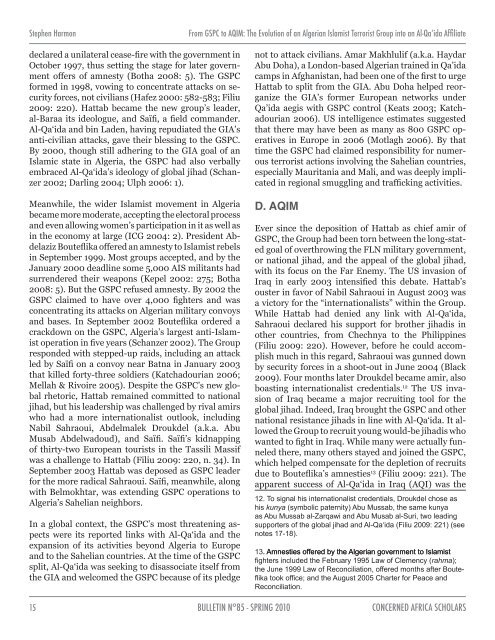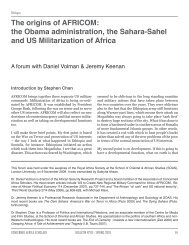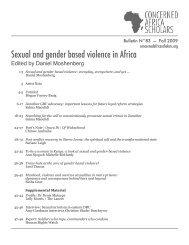Western Sahara and the United States' geographical imaginings
Western Sahara and the United States' geographical imaginings
Western Sahara and the United States' geographical imaginings
You also want an ePaper? Increase the reach of your titles
YUMPU automatically turns print PDFs into web optimized ePapers that Google loves.
Stephen Harmon From GSPC to AQIM: The Evolution of an Algerian Islamist Terrorist Group into an Al-Qa‘ida Affiliate<br />
declared a unilateral cease-fire with <strong>the</strong> government in<br />
October 1997, thus setting <strong>the</strong> stage for later government<br />
offers of amnesty (Botha 2008: 5). The GSPC<br />
formed in 1998, vowing to concentrate attacks on security<br />
forces, not civilians (Hafez 2000: 582-583; Filiu<br />
2009: 220). Hattab became <strong>the</strong> new group’s leader,<br />
al-Baraa its ideologue, <strong>and</strong> Saïfi, a field comm<strong>and</strong>er.<br />
Al-Qa‘ida <strong>and</strong> bin Laden, having repudiated <strong>the</strong> GIA’s<br />
anti-civilian attacks, gave <strong>the</strong>ir blessing to <strong>the</strong> GSPC.<br />
By 2000, though still adhering to <strong>the</strong> GIA goal of an<br />
Islamic state in Algeria, <strong>the</strong> GSPC had also verbally<br />
embraced Al-Qa‘ida’s ideology of global jihad (Schanzer<br />
2002; Darling 2004; Ulph 2006: 1).<br />
Meanwhile, <strong>the</strong> wider Islamist movement in Algeria<br />
became more moderate, accepting <strong>the</strong> electoral process<br />
<strong>and</strong> even allowing women’s participation in it as well as<br />
in <strong>the</strong> economy at large (ICG 2004: 2). President Abdelaziz<br />
Bouteflika offered an amnesty to Islamist rebels<br />
in September 1999. Most groups accepted, <strong>and</strong> by <strong>the</strong><br />
January 2000 deadline some 5,000 AIS militants had<br />
surrendered <strong>the</strong>ir weapons (Kepel 2002: 275; Botha<br />
2008: 5). But <strong>the</strong> GSPC refused amnesty. By 2002 <strong>the</strong><br />
GSPC claimed to have over 4,000 fighters <strong>and</strong> was<br />
concentrating its attacks on Algerian military convoys<br />
<strong>and</strong> bases. In September 2002 Bouteflika ordered a<br />
crackdown on <strong>the</strong> GSPC, Algeria’s largest anti-Islamist<br />
operation in five years (Schanzer 2002). The Group<br />
responded with stepped-up raids, including an attack<br />
led by Saïfi on a convoy near Batna in January 2003<br />
that killed forty-three soldiers (Katchadourian 2006;<br />
Mellah & Rivoire 2005). Despite <strong>the</strong> GSPC’s new global<br />
rhetoric, Hattab remained committed to national<br />
jihad, but his leadership was challenged by rival amirs<br />
who had a more internationalist outlook, including<br />
Nabil Sahraoui, Abdelmalek Droukdel (a.k.a. Abu<br />
Musab Abdelwadoud), <strong>and</strong> Saïfi. Saïfi’s kidnapping<br />
of thirty-two European tourists in <strong>the</strong> Tassili Massif<br />
was a challenge to Hattab (Filiu 2009: 220, n. 34). In<br />
September 2003 Hattab was deposed as GSPC leader<br />
for <strong>the</strong> more radical Sahraoui. Saïfi, meanwhile, along<br />
with Belmokhtar, was extending GSPC operations to<br />
Algeria’s Sahelian neighbors.<br />
In a global context, <strong>the</strong> GSPC’s most threatening aspects<br />
were its reported links with Al-Qa‘ida <strong>and</strong> <strong>the</strong><br />
expansion of its activities beyond Algeria to Europe<br />
<strong>and</strong> to <strong>the</strong> Sahelian countries. At <strong>the</strong> time of <strong>the</strong> GSPC<br />
split, Al-Qa‘ida was seeking to disassociate itself from<br />
<strong>the</strong> GIA <strong>and</strong> welcomed <strong>the</strong> GSPC because of its pledge<br />
15<br />
BULLETIN N°85 - SPRING 2010<br />
not to attack civilians. Amar Makhlulif (a.k.a. Haydar<br />
Abu Doha), a London-based Algerian trained in Qa’ida<br />
camps in Afghanistan, had been one of <strong>the</strong> first to urge<br />
Hattab to split from <strong>the</strong> GIA. Abu Doha helped reorganize<br />
<strong>the</strong> GIA’s former European networks under<br />
Qa’ida aegis with GSPC control (Keats 2003; Katchadourian<br />
2006). US intelligence estimates suggested<br />
that <strong>the</strong>re may have been as many as 800 GSPC operatives<br />
in Europe in 2006 (Motlagh 2006). By that<br />
time <strong>the</strong> GSPC had claimed responsibility for numerous<br />
terrorist actions involving <strong>the</strong> Sahelian countries,<br />
especially Mauritania <strong>and</strong> Mali, <strong>and</strong> was deeply implicated<br />
in regional smuggling <strong>and</strong> trafficking activities.<br />
D. AQIM<br />
Ever since <strong>the</strong> deposition of Hattab as chief amir of<br />
GSPC, <strong>the</strong> Group had been torn between <strong>the</strong> long-stated<br />
goal of overthrowing <strong>the</strong> FLN military government,<br />
or national jihad, <strong>and</strong> <strong>the</strong> appeal of <strong>the</strong> global jihad,<br />
with its focus on <strong>the</strong> Far Enemy. The US invasion of<br />
Iraq in early 2003 intensified this debate. Hattab’s<br />
ouster in favor of Nabil Sahraoui in August 2003 was<br />
a victory for <strong>the</strong> “internationalists” within <strong>the</strong> Group.<br />
While Hattab had denied any link with Al-Qa‘ida,<br />
Sahraoui declared his support for bro<strong>the</strong>r jihadis in<br />
o<strong>the</strong>r countries, from Chechnya to <strong>the</strong> Philippines<br />
(Filiu 2009: 220). However, before he could accomplish<br />
much in this regard, Sahraoui was gunned down<br />
by security forces in a shoot-out in June 2004 (Black<br />
2009). Four months later Droukdel became amir, also<br />
boasting internationalist credentials. 12 The US invasion<br />
of Iraq became a major recruiting tool for <strong>the</strong><br />
global jihad. Indeed, Iraq brought <strong>the</strong> GSPC <strong>and</strong> o<strong>the</strong>r<br />
national resistance jihads in line with Al-Qa‘ida. It allowed<br />
<strong>the</strong> Group to recruit young would-be jihadis who<br />
wanted to fight in Iraq. While many were actually funneled<br />
<strong>the</strong>re, many o<strong>the</strong>rs stayed <strong>and</strong> joined <strong>the</strong> GSPC,<br />
which helped compensate for <strong>the</strong> depletion of recruits<br />
due to Bouteflika’s amnesties 13 (Filiu 2009: 221). The<br />
apparent success of Al-Qa‘ida in Iraq (AQI) was <strong>the</strong><br />
. T� ������� ����� ������������������ ��������������, ����k���� �������� ���<br />
����� kunya ���ymb���� p��������y�� Ab� M������b, ����� ���m�� k��y�<br />
��� Ab� M������b ������q�w� ��� Ab� M����b ���S���, �w� ��������<br />
���pp�������� �� ����� ���b�� j����� ��� A�������� �F���� 009: �� �������<br />
������� � ���.<br />
3. . Am����������� Am����������� ��������� ��������� by ����� ����� A�������� A�������� ��v����m���� ��v����m���� �� �� I����m���� I����m����<br />
����������� ��������� ����� F��b����y 995 ��w �� C���m����y �rahma��;<br />
����� J���� 999 ��w �� R��������������, ��������� m������� ������ B������<br />
���k� ���k �������; ��� ����� A������ 005 C�������� ��� P������ ���<br />
R��������������.<br />
CONCERNED AFRICA SCHOLARS




